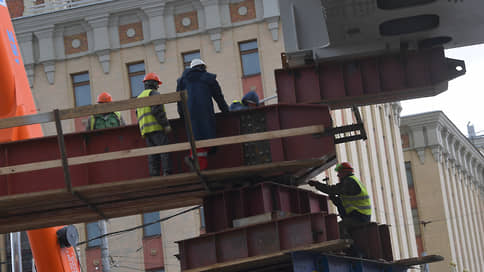Construction contractors and banks propose to reduce lending rates to 5.5% through government subsidies
[ad_1]

Construction contractors and banks propose that the government reduce current lending rates for the industry from 18.5% to 5.5% through government subsidies. Otherwise, they argue, the activity of investors and construction companies in infrastructure development projects may decline. Experts acknowledge the validity of the request, but also note the risk of rising costs of work and rising construction costs, as happened in the housing market after the launch of preferential mortgages.
Kommersant has at its disposal a letter from the executive director of the Association of Infrastructure Investors and Lenders (AIIC; unites the National Proektstroy Group of Companies, DSK Avtoban, the state company Avtodor, Sberbank, VTB, Gazprombank) Vadim Kalinin dated February 8, 2024 to the first deputy head Ministry of Economy to Ilya Torosov with a request to allocate loans for the construction of road transport infrastructure at a state-subsidized rate of 5.5% per annum.
To do this, the letter notes, the budget could compensate creditor banks for lost profits in the form of the difference between the Central Bank key rate, increased by 3 percentage points, and the preferential rate. The Ministry of Economy did not respond to Kommersant’s request.
The proposed mechanism would be of interest to banks, says Promsvyazbank Senior Vice President Kirill Boltromyuk. At the current cost of loans, infrastructure projects, according to Mr. Kalinin, “do not offer investors and contractors a return commensurate with the risk.”
In 2014, when the Central Bank’s key rate reached 18%, the authorities subsidized the lending rate for infrastructure construction, which supported the industry during the crisis, recalls Maria Yarmalchuk, CEO of the National Association of Infrastructure Companies.
In 2018–2023, 1.2 thousand km of federal highways were built in the Russian Federation with a total cost of 1.66 trillion rubles, as calculated by the AIIC. In the next five years, it is planned to invest about 13.6 trillion rubles in the construction of roads, airports, seaports and other transport infrastructure.
Now the cost of loans for infrastructure projects reaches 18.5–20%, explains Stroytransgaz JSC. At the same time, a small number of projects are profitable with lending rates above 12–14%, adds Sherpa Group CEO Alexandra Galaktionova. According to her, the high cost of financing is one of the main factors constraining investor activity in the industry.
This could lead to the suspension of construction, as happened with a number of commercial real estate projects, says General Director of Smart Engineers Group of Companies Hussein Pliev. Managing partner of Kachkin and Partners Denis Kachkin, in turn, notes that in 2023 the number of launched transport projects turned out to be extremely low compared to previous periods precisely because of the inaccessibility of financing.
“When high load on the market gives way to a period of low activity due to customer reductions in investments, the business of contractors ceases to be profitable,” explains Ruben Aganbegyan, deputy general director of the Natproektstroy Group of Companies.
According to Alexandra Galaktionova, subsidizing rates is a measure that can help avoid an investment pause, while it will require much less funds from the budget than if a large amount of transport infrastructure is built entirely at the expense of the state.
The payback period for infrastructure projects is very long, so the rate should be even lower than what AIIC proposes, and it would be even better to allocate grants for players, says Smart Container CEO Shamil Baishev.
However, the AIIC proposal also has obvious disadvantages, says Alexander Yakubovsky, a member of the State Duma Committee on Construction and Housing and Public Utilities. He cites the example of mortgage programs with state support, the widespread use of which was followed by a serious increase in prices for new buildings. In infrastructure construction, there is also a high risk that everyone will react to a serious increase in activity – from manufacturers and suppliers of building materials to contractors who will raise prices for their goods and services, the deputy believes.
“This is unlikely to be attractive for the state, which, in addition to subsidizing loans, will have to enter into more expensive contracts with contractors,” emphasizes Mr. Yakubovsky. Therefore, Alexandra Galaktionova is sure, such a measure should be applied to a limited range of projects.
[ad_2]
Source link





